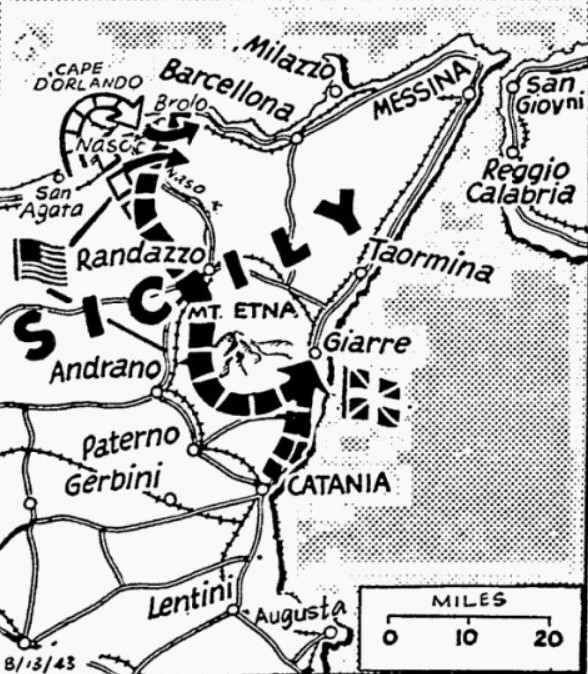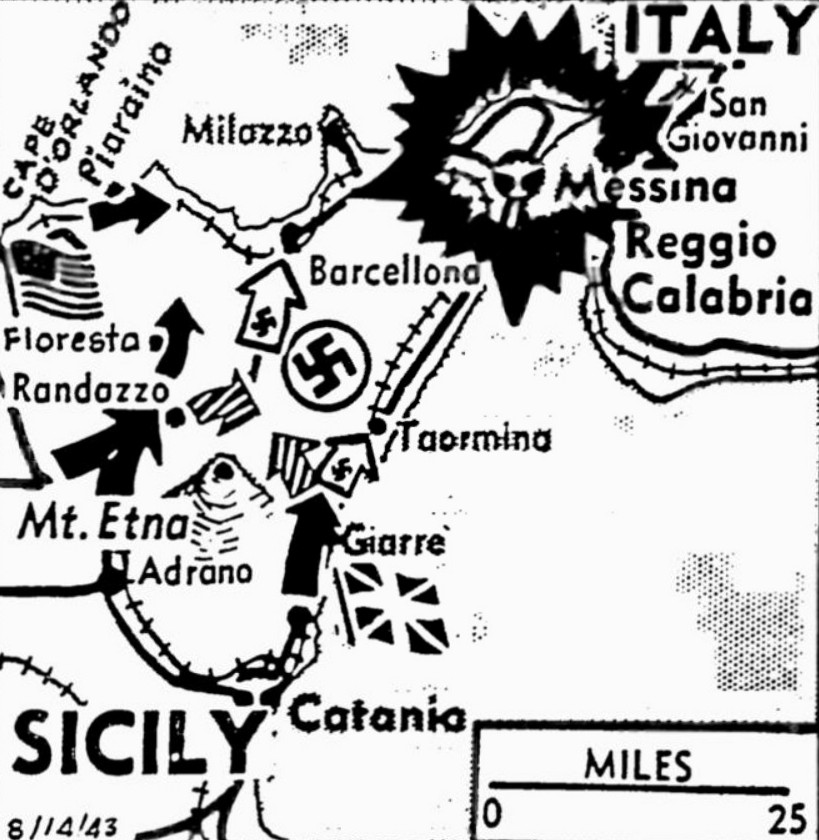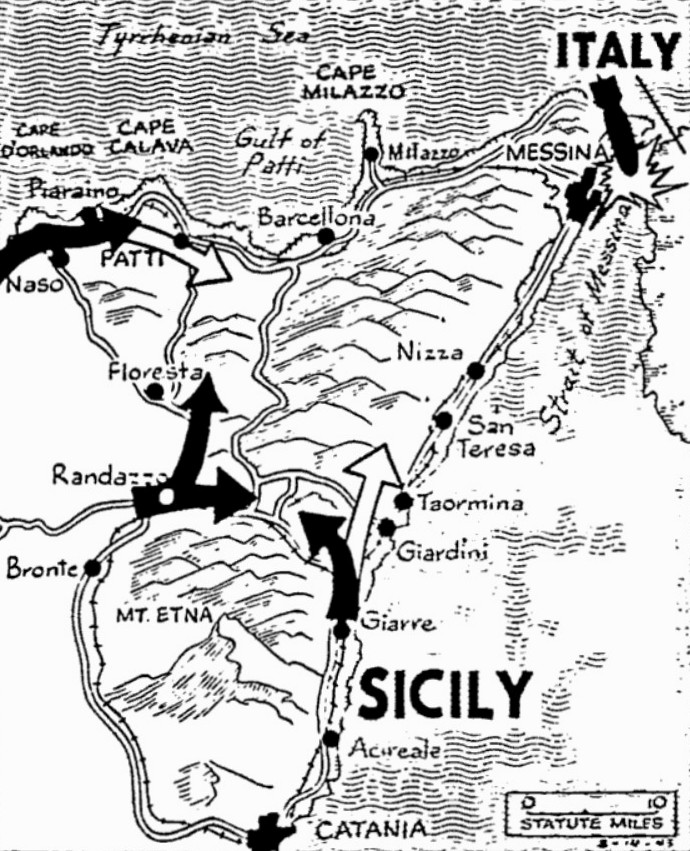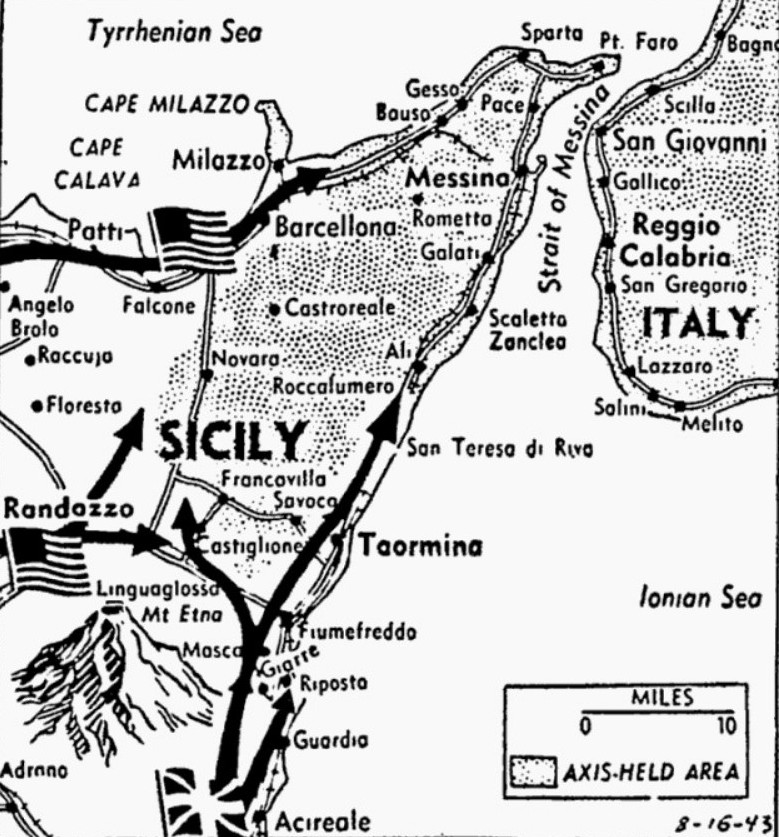The Pittsburgh Press (August 17, 1943)
Allies mop up Axis suicide units remaining in trap on island
By Reynolds Packard, United Press staff writer
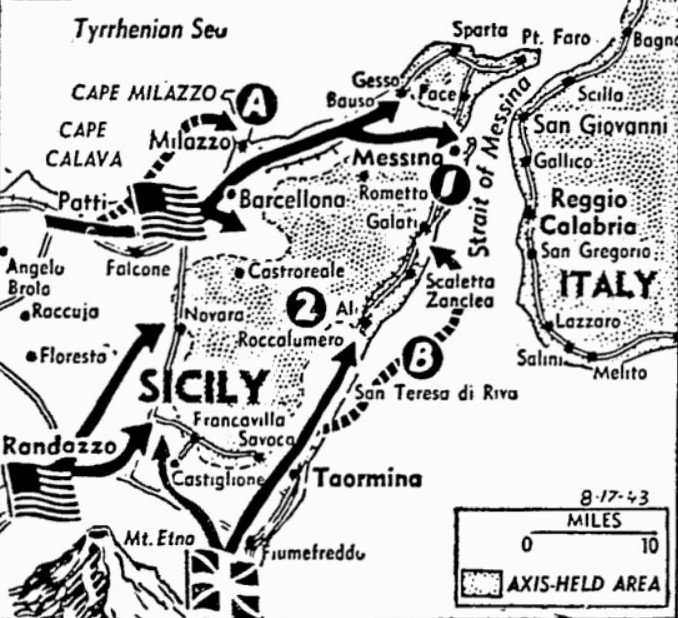
Capture of Messina by U.S. forces was announced today as the end of the Sicilian campaign was only hours away. Late developments on the island included:
1. The U.S. 7th Army drove into Messina and American guns were shelling the Italian
2. The British 8th Army drove northward along the coastal road, cleaning out Axis troops left as a rearguard.
A. Another landing on the north coast was made by the Americans, who went ashore near Milazzo, speeding up land drive.
B. A similar operation was performed by the British in a landing eight miles south of Messina.
Allied HQ, North Africa –
The Battle of Sicily ended today in a smashing Allied victory as U.S. troops stormed into Messina in the wake of an Axis evacuation to the Italian mainland and official announcement of the island’s complete occupation was expected at any moment.
Radio Algiers reported that the Americans had captured Messina. Reliable reports reaching London also said Messina had been taken. The Axis claimed to have evacuated all troops from Sicily.
All that remained for the U.S. 7th and the British 8th Armies on the narrow strip of Sicily along the Strait of Messina opposite Italy were cleanup operations against German and Italian suicide units.
A dispatch from United Press writer C. R. Cunningham, with the U.S. Army before Messina, reported that all ordered resistance had ended last evening and German noncommissioned officers falling into American hands explained they were expendables left behind to slow the Allied advance. Their officers and the German main body had fled.
U.S. artillery was shelling the Italian mainland, two miles across the Strait of Messina from Sicily, in a thunderous prelude to the next step of the Mediterranean offensive – the invasion of Italy proper.
A terrific artillery barrage unleashed at 3 a.m. yesterday (8 p.m. Sunday ET) softened the outer rim of Axis defenses for the successful American thrust into Messina, Sicily.
Gen. Dwight D. Eisenhower, in an address to a group of WACs, predicted that all of Sicily would be in Allied hands by midnight or earlier.
“Messina will fall tonight or tomorrow,” he said. He had just returned from Sicily by plane where he had conferred with field commanders.
Already, big guns were thundering the overture to the Battle of Italy proper. Allied and Axis artillery traded fire across the watery no-man’s-land of the Strait of Messina.
Axis demolition activity on the mainland was seen for the first time, indicating that the enemy was already preparing for whatever eventuality might result from the mop-up in Sicily.
Destroyers on patrol at the south end of the Strait of Messina clearly saw flames and smoke of explosions which marked the destruction of mainland installations that might be useful to the Allies later on.
The Northwest African Air Force yesterday turned much of its power against the Germans trying to escape northward through the toe of Italy, where roads and railways are barren, exposed targets.
The British push up the east coast highway toward Messina, bringing steadily closer a junction with the Americans along the north coast, was impeded by artillery fire from the mainland.
Some of this shellfire was also aimed at the Americans moving into Messina, but the terrain in the northern tip afforded them better protection.
A lightning advance of at least 20 miles brought the U.S. Army 3rd Division to outskirts of flaming, bomb-battered Messina last night and they moved into the city this morning.
The British 8th Army was believed only a few miles south of Messina following a daring commando landing eight miles south of the city and only nine miles across the Strait of Messina from Reggio Calabria on the Italian mainland.
Another U.S. amphibious landing – the third in a week – was also announced. The Americans pushed ashore from assault boats early yesterday near Milazzo, 16 miles west of Messina, but the town was soon far in the rear as the main forces effected a junction and slashed eastward.
Enemy resistance crumpled rapidly in the face of the final Allied onslaught and it was apparent that the Sicilian campaign had virtually ended five weeks and four days after U.S. and British troops first landed on the southern shores of the island.
The Axis command had apparently evacuated all the troops it could. Reconnaissance planes reported only a trickle of boats running the gauntlet of Allied bombs across the Strait of Messina yesterday.
Messina itself was only a burned-out shell of the former modern city of 176,500. The ruins resembled those left by the great earthquake of 1908, which razed the city.
It had been bombed without respite since the last days of the Tunisian campaign with particularly heavy raids being directed against it in the past week during the small-scale Italo-German “Dunkirk” evacuation to southern Italy.
Gen. Eisenhower’s communiqué revealed that the next-to-last chapter of the campaign yesterday saw the U.S. 7th Army overrunning enemy defenses as far east as San Giorgio, on the north coast within five miles of the eastern tip of the island, and Gesso, five miles west-northwest of Messina, before pushing on into the base itself.
The British 8th Army drove on through Santa Teresa di Riva, 18 miles south of Messina, in an eight-mile advance from Taormina, the communiqué said, and then leapfrogged their line 10 miles to the north with a commando landing on the east coast across from Reggio Calabria.
The commandos were shelled by Axis guns near Reggio Calabria, but quickly overcame sharp resistance put up by Axis rearguards and pressed northward toward Messina and a rendezvous with the 7th Army.
The day’s only counterattack on either coast was repulsed by the British about five miles north of Taormina.
Captured documents showed that the Germans left two Italian coastal regiments to hold a line between Taormina and the north coast to cover the evacuation from Messina, but this line was shattered by the commando landing south of Messina.
The collapse of enemy resistance along the north coast was demonstrated by the ease with which U.S. warships landed amphibious troops near Milazzo early Monday. Only last week, a bloody battle developed when a similar force landed west of Capo d’Orlando.
Allied reconnaissance pilots reported decreased anti-aircraft fire over the Strait of Messina beginning yesterday and it was soon apparent that the Axis was about to end its evacuation attempt. Soon afterward, fire from the Italian mainland was stepped up, indicating that some guns had been ferried across from Sicily.
Allied and Axis artillery were dueling across the Strait of Messina.
A naval communiqué said Allied naval forces sighted Axis demolitions in northern Sicily and also on the mainland near Reggio Calabria Saturday night.
That same night, it added, the warships bombarded southwestern Italy, sending 1,000 shells into Scalea on the south side of the Gulf of Policastro and hitting shore batteries on Cape Pellaro. Early Monday, other naval forces bombarded Port Vibo Valentia on the Gulf of Saint Eufemia. Gunboats and destroyers also bombarded the east coast road to Messina daily while light coastal forces operated in the strait nightly.
British warships were credited with sinking an armed light cruiser and two escort craft early Monday south of Cape Boniface. U.S. naval units drove off a light formation of enemy torpedo boats north of Messina yesterday.
